一种新型血管内生物人工胰腺装置在非糖尿病猪身上显示出三十天的安全性和胰岛功能。
IF 8.9
2区 医学
Q1 SURGERY
引用次数: 0
摘要
在这项研究中,我们使用了一个不和谐的异种移植模型,证明了首个基于支架的生物人工胰腺装置的功能性和安全性,该装置通过血管内植入动脉,利用血液中的高含氧量支持胰岛的存活。该装置是一种自膨胀镍钛诺支架,表面涂有双层聚四氟乙烯(PTFE),形成通道以容纳嵌入水凝胶中的小胰岛。我们在非糖尿病猪模型(N=3)中完成了一项为期一个月的研究,以测试该装置的安全性,并评估装置回收后的胰岛功能。第 0 天和第 30 天,三只动物的装置管腔直径分别为 10.01 ± 0.408 毫米和 10.05 ± 0.25 毫米。第 30 天取出的对照组和 eBAP 装置的刺激指数分别为 3.35 ± 0.97 和 4.83 ± 1.20,30 天后体内胰岛素和胰高血糖素染色呈阳性。这项试验研究表明,将 BAP 植入外周动脉是安全的,并能在 30 天内支持胰岛功能,为今后评估该装置在糖尿病猪体内的功能奠定了基础。本文章由计算机程序翻译,如有差异,请以英文原文为准。
A novel intravascular bioartificial pancreas device shows safety and islet functionality over 30 days in nondiabetic swine
In this study using a discordant, xenogeneic, transplant model we demonstrate the functionality and safety of the first stent-based bioartificial pancreas (BAP) device implanted endovascularly into an artery, harnessing the high oxygen content in blood to support islet viability. The device is a self-expanding nitinol stent that is coated with a bilayer of polytetrafluoroethylene that forms channels to hold islets embedded in a hydrogel. We completed a 1-month study in the nondiabetic swine model (N = 3) to test the safety of the device and to assess islet functionality after device recovery. The luminal diameter of the devices from 3 animals on day 0 and day 30 was 10.01 ± 0.408 mm and 10.05 ± 0.25 mm, respectively. The stimulation index of the control and endovascular BAP devices explanted at day 30 were 3.35 ± 0.97 and 4.83 ±1.20, respectively, and the islets stained positively for insulin and glucagon after 30 days in vivo. This pilot study shows that BAP implantation into a peripheral artery is safe and supports islet functionality over 30 days, providing the groundwork for future work assessing the in vivo function of the device in diabetic swine.
求助全文
通过发布文献求助,成功后即可免费获取论文全文。
去求助
来源期刊
CiteScore
18.70
自引率
4.50%
发文量
346
审稿时长
26 days
期刊介绍:
The American Journal of Transplantation is a leading journal in the field of transplantation. It serves as a forum for debate and reassessment, an agent of change, and a major platform for promoting understanding, improving results, and advancing science. Published monthly, it provides an essential resource for researchers and clinicians worldwide.
The journal publishes original articles, case reports, invited reviews, letters to the editor, critical reviews, news features, consensus documents, and guidelines over 12 issues a year. It covers all major subject areas in transplantation, including thoracic (heart, lung), abdominal (kidney, liver, pancreas, islets), tissue and stem cell transplantation, organ and tissue donation and preservation, tissue injury, repair, inflammation, and aging, histocompatibility, drugs and pharmacology, graft survival, and prevention of graft dysfunction and failure. It also explores ethical and social issues in the field.

 求助内容:
求助内容: 应助结果提醒方式:
应助结果提醒方式:


